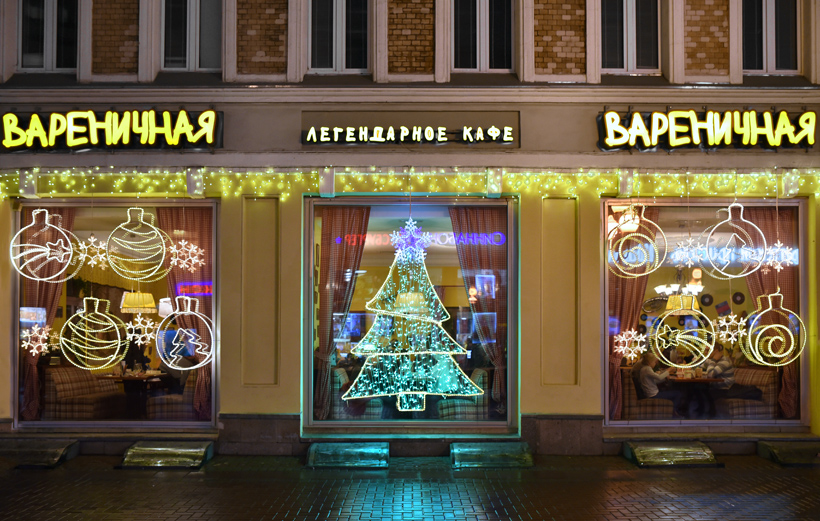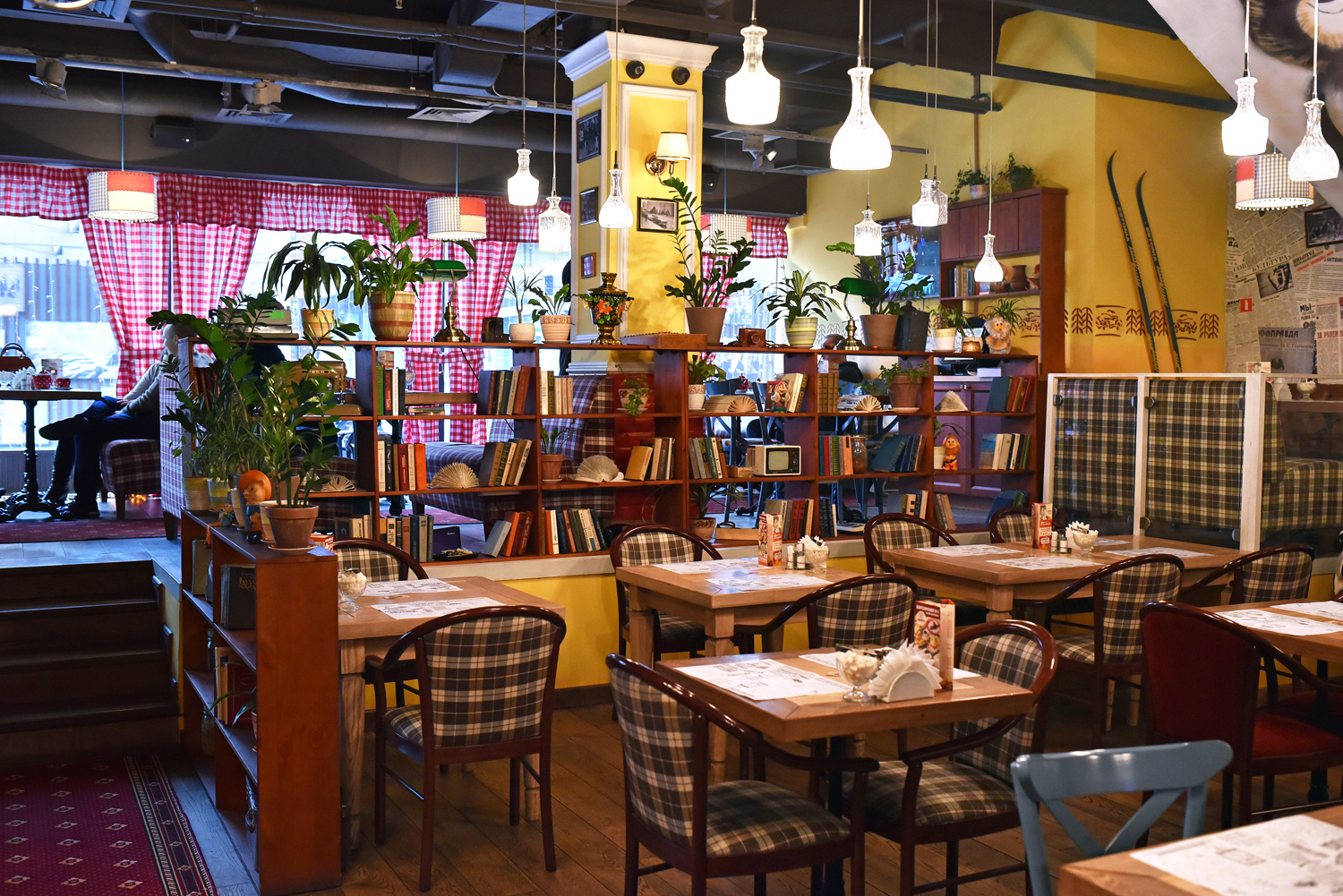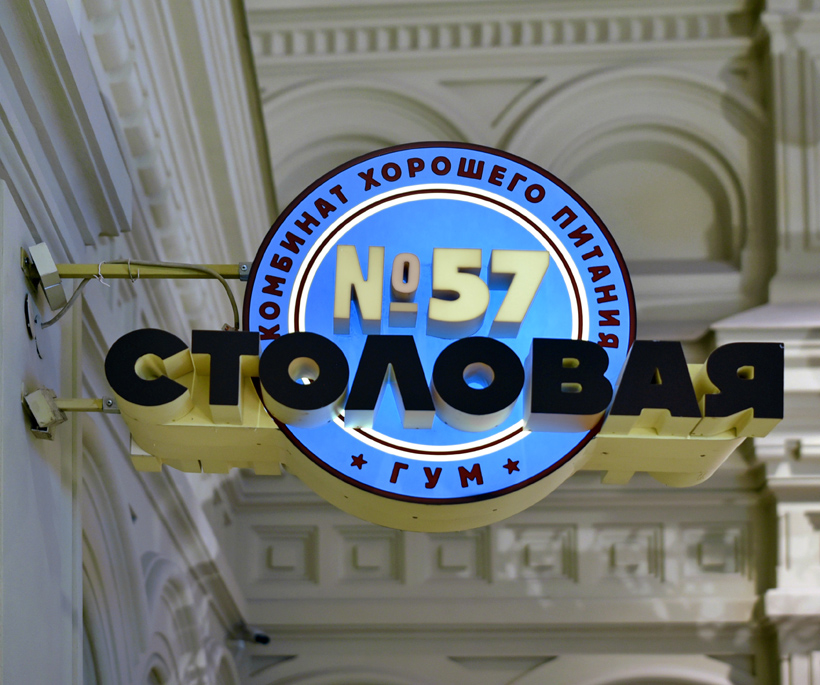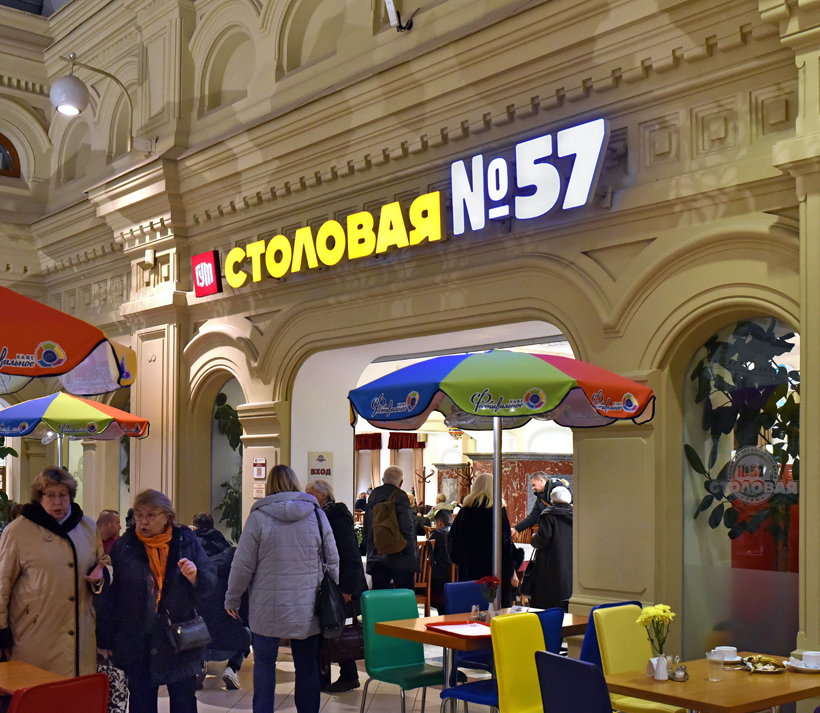Soviet nostalgia is nothing new – it probably started on December 26, 1991, if not earlier. And it’s somewhat understandable, too. Back in the USSR, there was a feeling of guaranteed stability, and of belonging to a superpower. They didn’t have to worry about their job, their rent, their bills, their retirement, or anything in the future. It certainly helped that most people didn’t have any real point of comparison by which to assess their living standards.
Today, more than an entire generation has never lived in the Soviet Union. To them, the vanished empire has a kind of retro appeal, just like the seventies and eighties do in so many other countries. And they are curious: how did their parents and grandparents live? What was it like, in that country that no longer exists?
So, along with the nostalgia comes a renewed interest in things Soviet. The once reviled Brutalist architecture now has its fans, and countless tomes collect pictures of the remaining exemplars scattered across the former Soviet Republics, whether they’re miscellaneous buildings, sanatoriums, or bus stops. Soviet posters have been hugely popular for years, and reprints are available in Russia’s museums and bookstores in every format imaginable. Soviet photographic equipment is making a comeback, inspiring many of Lomography‘s toy cameras, or providing medium format film photographers with affordable options such as reconditioned Kiev cameras. Soviet arcade games are being rediscovered thanks to museums in Moscow and Saint Petersburg that repair them and let visitors play.

But when it comes to Soviet food, there’s really not much to be nostalgic or curious about. Except perhaps for childhood candies and chocolates, can one really have fond memories of what they ate in a country that was plagued with famines and food shortages for most of its existence, and forced all of its restaurants to choose their dishes from a single list of approved recipes? The Soviet Union’s contributions to gastronomy mostly consisted of drenching salads in industrial mayonnaise, adding bland cheese to anything that seemed in need of gourmet luster, and the systematic use of ground or boiled meat to such an extent that one couldn’t be faulted for believing that Soviet animals naturally grew that way. Do you think the Soviet Arcade Game Museum serves Soviet food? No, it serves American-style burgers – which, incidentally, inspired the cheap, semi-processed ground meat cutlets ubiquitous in the USSR! And if Homo Sovieticus spent a significant part of his or her life in the kitchen, it wasn’t just to eat, but rather to spend time with friends and family – or to drink.
True, there have been some books on the subject recently, like Anya von Bremzen’s Mastering the Art of Soviet Cooking: A Memoir of Food and Longing, or CCCP Cook Book: True Stories of Soviet Cuisine. But then, who actually cooks recipes from books anymore? The former, which I recommend reading, is really more a memoir with a few recipes than an actual cookbook. The latter, if more recipe-centric, includes stories and anecdotes about each dish. Hell, even Red Sparrow, a spy novel by an American author, contains some Soviet recipes.
But in this day and age, would anyone ever opt to eat that dreadful stuff over the many tastier / healthier / better looking alternatives we’re surrounded with? Seriously?
Apparently, yes. The best proof comes from the bizarre popularity of Stolovaya №57, the re-creation of a Soviet cafeteria in Moscow’s GUM, the ultimate luxury department store, right on Red Square. It’s a little bit as if Bergdorf Goodman‘s customers all stood in line to eat at a truck stop (as far as I know, even Brooklyn hasn’t gentrified the truck stop yet). Between purchasing Gucci bags and Hugo Boss suits, shoppers at the iconic GUM get to wax nostalgic about the good old days for a few minutes while filling their trays with unappetizing food and sitting in an austere dining room. Do they also remember that back then, all they could buy in the half-empty GUM were cheap Soviet clothes (when in stock) and Lenin badges (always in stock)? You can miss the Soviet Union, you can miss your childhood, but why oh why would you miss empty stores and cafeterias serving nasty food?
On the other hand, for those looking for a more digestible version of Soviet nostalgia, there’s Varenichnaya №1, a restaurant chain with twenty or so locations all over Moscow (they’re all №1). The focus is first and foremost on the decor; each branch welcomes you into an interior reminiscent of a Soviet apartment, complete with memorabilia that Russians grew up with or maybe saw when visiting their grandparents: retro photos, vinyl records, books, film cameras… Each is unique and has its own style, though all share a cozy atmosphere and a common menu. Today we’ll visit the location on the New Arbat, where the amply decorated dining room, on a street that once was the showcase of Soviet urbanism, exemplifies the concept.
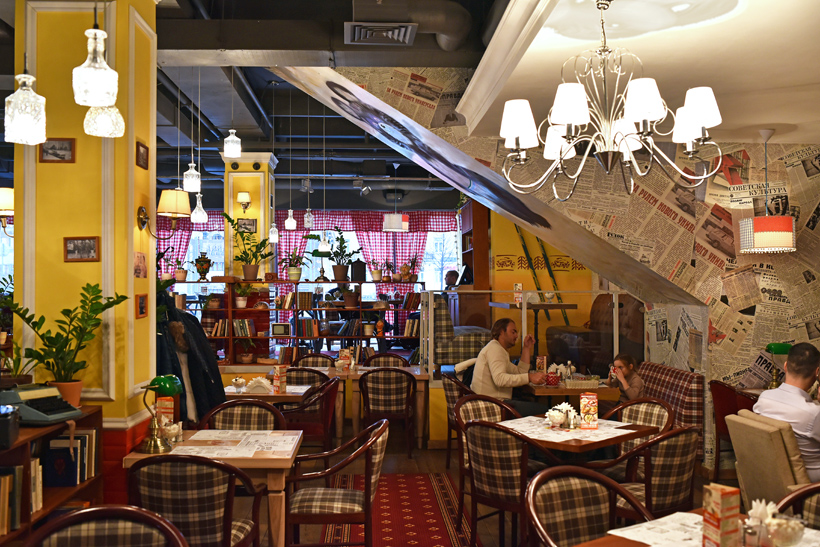
Although you’ll find several Soviet classics on the menu, the owners are careful to put the emphasis elsewhere. With the name of the restaurant, first: a varenichnaya is a place that serves varenyky (or vareniki, to use the Russian spelling), similar to Polish pierogies. Were these dumplings consumed in the USSR? Absolutely. Especially since they could feed a nation on the cheap with little bits of second-grade meat cuts or vegetables, wrapped in plenty of dough. But vareniki are mostly known as one of Ukraine’s national dishes, and have existed for centuries. Varenichnaya №1 prepares more than twenty different types of vareniki – whereas my 1952 edition of Anastas Mikoyan’s 1939 Book of Tasty and Healthy Food, the Soviet culinary bible, contains only one recipe for them. If a Soviet restaurant had claimed to serve twenty kinds of vareniki, most of them would have been eighty-sixed.
Then, Varenichnaya №1’s website never specifically mentions “Soviet cuisine,” but rather “traditional dishes of Russian and Ukrainian cuisine” – even as it mentions herring under a fur coat and chicken Kiev, two staples of Soviet cookery. This is the restaurant’s secret sauce: homey Russian and Ukrainian food whose connection to the USSR is reinforced by the retro decor; dishes that, although popular in the USSR, are prepared according to older traditional recipes, with more variety, better ingredients, and more careful plating. It’s like melba toast transformed into madeleines to gain both gastronomical acceptance and Proustian potency.
So let’s deep dive into the details of the menu. The first thing one notices is of course the long list of vareniki. Savory dumplings served in a bowl or in a clay pot, filled with potatoes, cabbage, mushrooms, spinach, veal, pork, beef, beef tongue, chicken, cheese, or some combination of the above. Sweet dumplings with mixtures made variously of tvorog, raisins, apple, cherry, black currant, vanilla, cinnamon, and chocolate. Oh and there’s also pelmeni: Siberian pelmeni (beef and pork blend), Siberian pelmeni in chicken stock, Siberian pelmeni in mushroom sauce, Ural pelmeni, baked pelmeni in pepper sauce, pelmeni with rabbit, pelmeni with pike and tartar sauce, and pelmeni with smoked pork and crispy onion!

There’s a selection of salads, either contemporary-looking with fresh vegetables, or more Soviet-looking lumps covered with mayonnaise (beets with prunes, herring under a fur coat, Mimosa, Olivier). The appetizer section continues with a salo plate, a cheese plate, a pickled vegetable plate, various cold meat plates, and herring on potato slices. Beer drinkers can order the more American-leaning beer plate: chicken wings, fried onion, garlic croutons, and smoked cheese.
The soups include half a dozen traditional Russian and Ukrainian options. The mains, on the other hand, mix classics (Uzbek plov, kasha, goulash in a bread loaf, golubtsy, beef Stroganoff) and more contemporary creations, such as salmon-spinach pie, chicken thigh in walnut-mustard marinade with potatoes and zucchini, baked Coho salmon in mustard-honey sauce with rice and vegetables.
And it goes on! Pies, a trending pillar of Russian cuisine, have their own section: puff pastry with mushrooms, pirozhki with meat, egg and onion, pirozhki with cabbage, pirozhki with cherries. Cutlets, another pillar of Russian cuisine, also have their own section, with versions including fish, “homemade” (a meat blend, I guess), chicken, or chicken Kiev-style. And draniki, potato or zucchini pancakes to which you can add a variety of toppings, from grilled beef to a whole glass of sour cream. And chebureki, deep-fried turnovers made with sulguni, beef, or lamb.
Desserts include a selection of blini, classic Russian cakes (medovik, Napoleon), or Soviet creations (bird’s milk cake, Prague cake, oreshki cookies).
There’s a also a breakfast menu (stuffed blini, oladi, syrniki, tvorog cake), and a “fitness” menu (salads, lavash wraps). Phew!

All right, finally time to try some of the food. The forshmak is a sort of herring pâté mixed with bread or potatoes to milden its taste. It’s usually eaten on black bread, with scallions on the side and a shot of vodka. Pretty good.

And now for the ultimate Soviet food experience: the herring under a fut coat! Layers of onions, herring, potatoes, carrots, and red beets, with such liberal amounts of mayo that calling this dish a salad would be an insult to the Ministry of Health. These could all be worthy ingredients except for the mayo, but they’re assembled in the grossest fashion. For one thing, tossing or stacking too many ingredients together – especially ones with bold flavors – and hoping for the best tends to produce a result inferior to the sum of its parts. For another, the mayo-laced layers, pulled down by gravity, invariably start mixing into an indistinguishable blob the color of vomit on an emergency room floor, and no cute little sprig of parsley can save appearances. This is a perfect example of how not to convince children to eat fish or vegetables. Chances are adults won’t be convinced either.

Cutlets are another Soviet classic, probably because a dish made of ground meat can be made with almost any animal part, thus helping to work around meat scarcity. Varenichnaya №1’s chicken cutlets (non-Kiev-style) are laced with cheese, and served with potato purée and sliced cucumber. Strange choice, if you ask me, but in Russia, a day without cucumber is like a day without sun (notwithstanding the many days without sun in winter). The cutlets are made well.
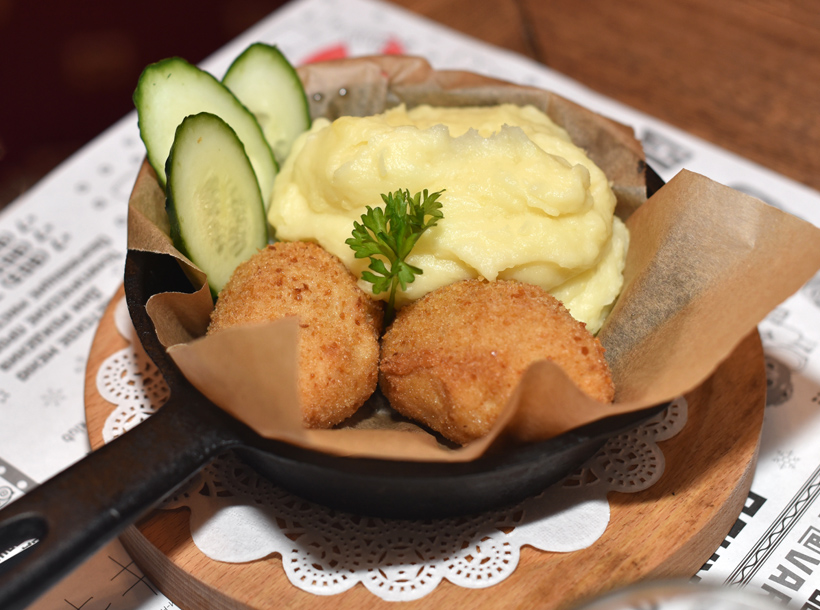
The borscht follows a classic Ukrainian recipe with beet, cabbage, carrot, potato, onion, and beef. It’s served with a dollop of cream and some chopped dill, plus a side of pampushky (little buns) with garlic sauce.
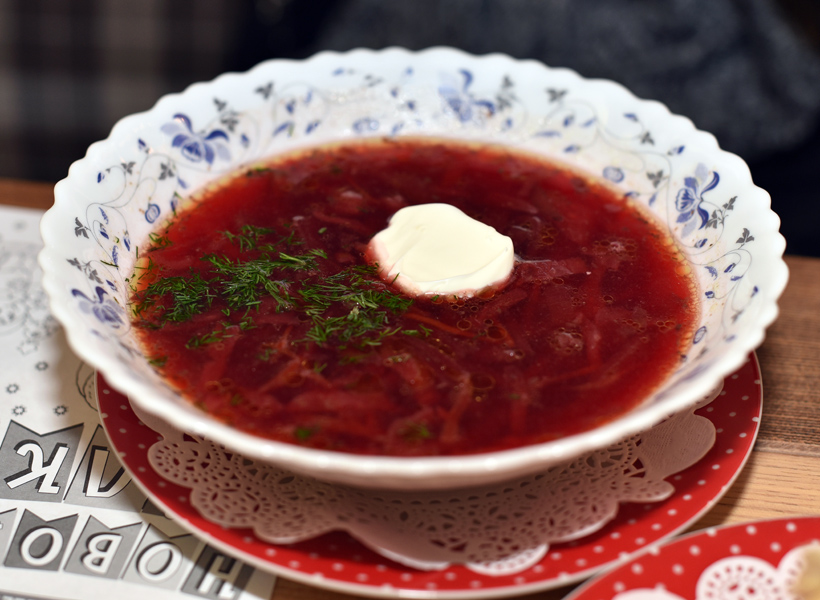
Let’s try a few of the eponymous vareniki! If you order the dumplings in a bowl, they arrive with sprinkled fried onion. However, if you order them in a clay pot, they come topped with small cubes of stewed veal with cream and onions. In both cases, they’re mixed with butter, without sour cream or broth.
The veal vareniki are very good. As per usual, the dough is on the thick side for a dumpling, but it strikes a good balance with the filling. The ground meat inside is quite compact but not dry.
But the mushroom and cabbage vareniki are my favorite. Same dough and same size as the veal version, but with a very juicy and soft filling. If you’re afraid you’ll miss the meat, there’s the stewed veal on top anyway!
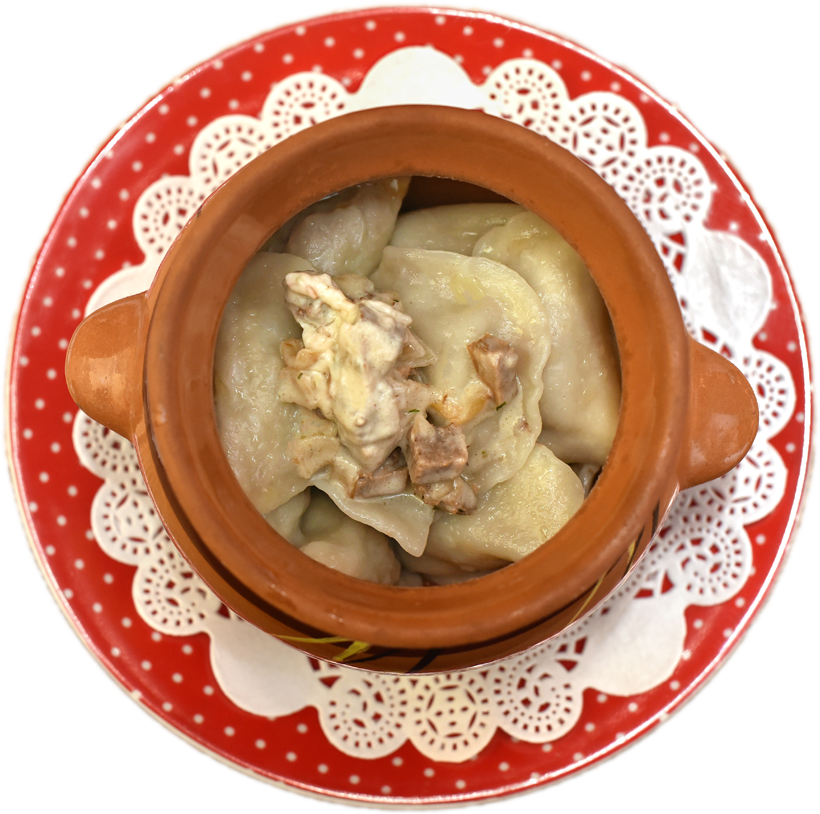
The vareniki Poltavan-style seem pretty similar at first, just a bit larger than the others. What makes them Poltavan? Apparently, it’s the dough, soft and airy, made with kefir, and rolled a bit thinner. Poltavan-style vareniki can be filled with anything, but here the filling is a blend of veal and pork, with maybe a bit of onion, ground very finely, almost to a purée. They’re topped with fried ground meat, carrots, and onions. No question, these are very good too.

Dessert is perhaps the course with the most Soviet options at Varenichnaya №1. The oreshki are cookies shaped like whole walnuts, filled with cooked sweetened condensed milk – a favorite of every Soviet child. And they’re not bad, though for grown-ups the flavors are kind of limited, just sugar and baked dough.
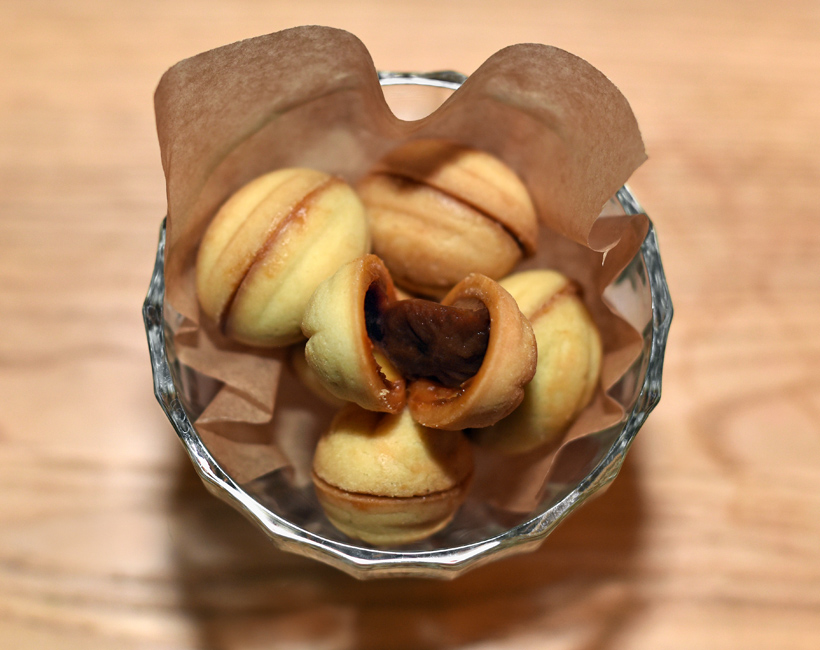
The bird’s milk cake is also made with sweetened condensed milk. The super-sweet dairy (which has its very own monument in Belarus) is prepared into a mousse, then sandwiched thinly between two layers of cake topped with a coating of dark chocolate. This dessert, which began as a candy, was turned into a cake in the late seventies by chef Vladimir Guralnik at Moscow’s Praga Restaurant. Varenichnaya №1 adds a gooseberry on top. Again, the dessert is really, really sweet and tastes mostly of sugar; the flavor of the condensed milk doesn’t come through.

In the end, where Varenichnaya №1 succeeds best is in recreating a Soviet home – a sentimentally important mission for people born in a country that no longer exists, as well as their younger offspring. Diners come with their friends and family, for a weekend meal or to celebrate a birthday. Re-reading the recipes from Anya von Bremzen’s Mastering the Art of Soviet Cooking: A Memoir of Food and Longing, the feeling is no different: “Kotleti, Mom’s Russian Hamburgers,” a “Salat Olivier” to which “Mom gives […] an arty, non-conformist twist by adding fresh cucumbers and apple, and substituting crabmeat for chicken,” “Dad’s Uber-Borsch.” There’s no place like home, so it makes sense that the food served is, for the most part, homey. Even if the restaurant is not an actual home where people lived and loved, but an idealized, roomier, imaginary version.
